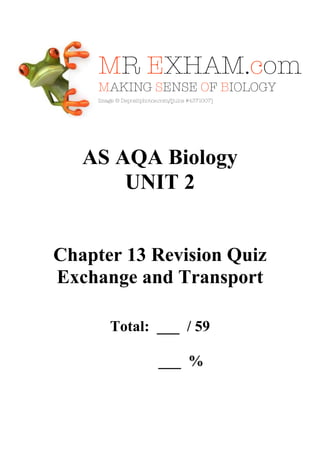AQA AS Biology - Unit 2 - Chapter 13
This document contains a 32 question quiz on exchange and transport in biology. It covers topics like the substances exchanged between organisms and the environment, surface area to volume ratios, features of specialized exchange surfaces, gas exchange in single-celled organisms and insects, the tracheal system in insects, stomata, gills, countercurrent flow in gills, chloroplasts in leaves, leaf structure and adaptations for gas exchange, the need for transport systems in larger organisms, open vs closed circulatory systems, single vs double circulatory systems, blood vessel layers, differences between arteries and veins, capillary structure and function, interstitial fluid and lymphatic system, labeling a diagram of circulatory system structures, root hair cells,

Empfohlen
Weitere ähnliche Inhalte
Was ist angesagt?
Was ist angesagt? (17)
Ähnlich wie AQA AS Biology - Unit 2 - Chapter 13
Ähnlich wie AQA AS Biology - Unit 2 - Chapter 13 (20)
Mehr von mrexham
Mehr von mrexham (17)
Kürzlich hochgeladen
Kürzlich hochgeladen (20)
AQA AS Biology - Unit 2 - Chapter 13
- 1. AS AQA Biology UNIT 2 Chapter 13 Revision Quiz Exchange and Transport Total: ___ / 59 ___ %
- 2. 1. Name 4 substances that need to be interchanged between an organism and its environment. (4) ………………………………………………………………....... ………………………………………………………………....... 2. If a cube has sides that are 1cm long, what is its surface area to volume ratio? (1) ………………………………………………………………....... 3. Name 3 features of a specialised exchange surface (3) ………………………………………………………………....... ………………………………………………………………....... ………………………………………………………………....... 4. By what process do single celled organisms and insects exchange gases? (1) ………………………………………………………………....... 5. What is the network of tubes called in an insect that allows it to diffuse gases? (1) ………………………………………………………………....... 6. What are the tiny pores called on the body surface that allow the gases in and out? (1) ……………………………………………………………….......
- 3. 7. What are gills made from? (1) ………………………………………………………………....... 8. What is it called when the blood and the water flow in opposite directions? (1) ………………………………………………………………....... 9. How does this help the blood absorb more oxygen? (1) ………………………………………………………………....... ………………………………………………………………....... 10. What are the pores called in leaves that allows gas exchange to occur? (1) ………………………………………………………………....... 11. What are the main cell layers of a leaf? (2) ………………………………………………………………....... ………………………………………………………………....... ………………………………………………………………....... 12. (3) How is the leaf adapted for efficient gas exchange? ………………………………………………………………....... ………………………………………………………………....... ……………………………………………………………….......
- 4. 13. (2) Why do larger organisms need a transport system? ………………………………………………………………....... ………………………………………………………………....... 14. Is a mammals transport system open or closed? (1) ………………………………………………………………....... 15. Do mammals have a single or double circulatory system? (1) ………………………………………………………………....... 16. What are the 5 layers of a blood vessel? (5) ………………………………………………………………....... ………………………………………………………………....... ………………………………………………………………....... ………………………………………………………………....... ………………………………………………………………....... 17. Give three differences between the structure of an artery compare to a vein. (3) ………………………………………………………………....... ………………………………………………………………....... ……………………………………………………………….......
- 5. 18. How is the structure of a capillary related to its function? (2) ………………………………………………………………....... ………………………………………………………………....... ………………………………………………………………....... 19. What is the watery liquid called that is forced out of the capillary? (1) ………………………………………………………………....... 20. What causes this liquid to be forced out? (1) ………………………………………………………………....... 21. Not all of this fluid can return directly to the blood vessels, what is the reminder carried by? (1) ………………………………………………………………....... 22. Label the following diagram: (5)
- 6. 23. Which cells take up the water in the roots? (1) ………………………………………………………………....... 24. After water is absorbed into the root, what are the two pathways it can take? (2) ………………………………………………………………....... ………………………………………………………………....... 25. What does the casparian strip do? (2) ………………………………………………………………....... ………………………………………………………………....... ………………………………………………………………....... 26. How is water lost through the leaves? (1) ………………………………………………………………....... ………………………………………………………………....... 27. By what process does water get transportedup the xylem vessels?(1) ………………………………………………………………....... 28. Name two benefits to transpiration (2) ………………………………………………………………....... 29. Name four factors that affect the rate of diffusion (2) ……………………………………………………………….......
- 7. 30. What piece of apparatus can you use to measure the rate of water uptake? (1) ………………………………………………………………....... 31. What type of plants are adapted for reducing water loss? (1) ………………………………………………………………....... 32. Name four adaptations that these plants have? (4) ………………………………………………………………....... ………………………………………………………………....... ……………………………………………………………….......
